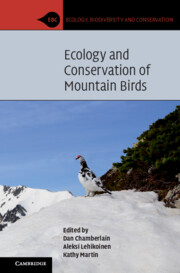Book contents
- Ecology and Conservation of Mountain Birds
- Ecology, Biodiversity and Conservation
- Ecology and Conservation of Mountain Birds
- Copyright page
- Contents
- Contributors
- Preface
- Acknowledgements
- 1 Mountain Birds and Their Habitats
- 2 Avian Adaptations to High Mountain Habitats
- 3 Global Bird Communities of Alpine and Nival Habitats
- 4 Birds of Treeline Ecotones
- 5 Population Trends of Mountain Birds in Europe and North America
- 6 Climate Change Impacts on Mountain Birds
- 7 Anthropogenic Activities and Mountain Birds
- 8 Modelling Large-Scale Patterns in Mountain Bird Diversity and Distributions
- 9 The Alpine Avifauna of Tropical Mountains
- 10 Priorities for Information, Research and Conservation of Birds in High Mountains
- Bird Species Index
- Subject Index
- Plate Section (PDF Only)
- References
3 - Global Bird Communities of Alpine and Nival Habitats
Published online by Cambridge University Press: 30 June 2023
- Ecology and Conservation of Mountain Birds
- Ecology, Biodiversity and Conservation
- Ecology and Conservation of Mountain Birds
- Copyright page
- Contents
- Contributors
- Preface
- Acknowledgements
- 1 Mountain Birds and Their Habitats
- 2 Avian Adaptations to High Mountain Habitats
- 3 Global Bird Communities of Alpine and Nival Habitats
- 4 Birds of Treeline Ecotones
- 5 Population Trends of Mountain Birds in Europe and North America
- 6 Climate Change Impacts on Mountain Birds
- 7 Anthropogenic Activities and Mountain Birds
- 8 Modelling Large-Scale Patterns in Mountain Bird Diversity and Distributions
- 9 The Alpine Avifauna of Tropical Mountains
- 10 Priorities for Information, Research and Conservation of Birds in High Mountains
- Bird Species Index
- Subject Index
- Plate Section (PDF Only)
- References
Summary
Alpine grassland and nival zones are characterized by variable environmental conditions, compressed breeding seasons, and limited resources such as food and nest site availability. As a result, high elevation habitats around the world contain an impressive diversity of unique bird species, highly specialized to thrive in challenging environmental conditions with limited breeding opportunities. In this chapter, we highlight the global diversity of alpine habitats and avifaunal communities. We first define general features of alpine and nival zones, before providing an overview of these habitats across 10 major regions around the world. Assembling a global list of alpine breeding birds, we then summarize what makes alpine avifauna unique and how communities vary regionally. Specifically, we focus on traits that characterize how species interact with their environment: i) alpine specialization and endemism, ii) nesting strategies, and iii) migration behaviour. Finally, we address some of the main eco-evolutionary drivers that shape these alpine communities, including climate, vegetation structure, food availability, and species interactions. We conclude by discussing the critical role snow dynamics play in maintaining many alpine bird communities and highlight the concerning trends associated with a rapidly changing climate that are putting pressure on alpine birds.
Keywords
- Type
- Chapter
- Information
- Ecology and Conservation of Mountain Birds , pp. 90 - 136Publisher: Cambridge University PressPrint publication year: 2023



